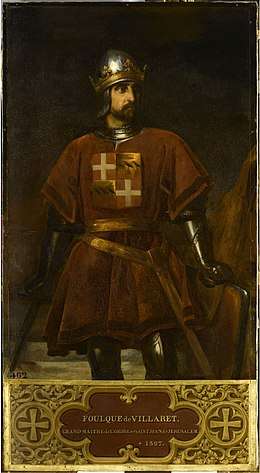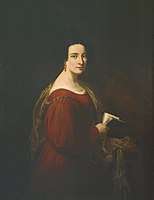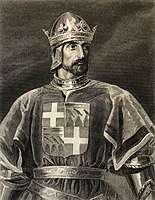Eugène Goyet
Eugène Goyet (7 February 1798—7 May 1857), was a French artist. Beginning in 1827 his work was regularly selected for exhibition in the annual Paris Salon. He achieved his greatest success as a painter of religious subjects, with his paintings of Christ and various saints installed in churches and public buildings across France. A successful portrait painter, his most prestigious commission was his 1847 portrait of Pope Pius IX. He was the son of self-taught artist Jean-Baptiste Goyet, and husband of the pastel portrait artist Zoé Goyet.
Eugène Goyet | |
|---|---|
| Born | Eugène Goyet 7 February 1798 |
| Died | 7 May 1857 (aged 59) |
| Education | atelier of Antoine-Jean Gros |
| Spouse(s) | Zoé Goyet |
| Parents |
|
| Signature | |
 | |
Career

Having shown an aptitude for drawing, Goyet was sent at the age of eighteen to Paris to receive formal training. Eugène ranked at the top of his class of sixty students at the atelier of Antoine-Jean Gros.[1]
At some point Goyet's parents also moved to Paris, with the family taking up residence at 3 Rue de l'Abbaye. Father and son were to have a close lifelong relationship, residing at the same address and working in the same studio. They made their debuts at the Paris Salon in the same year, 1827, when Jean-Baptiste was 48 and Eugène was 29. From that point, both Goyets regularly had works selected for exhibition in the Salons, as did Eugène's wife, Zoé, a portrait artist who specialized in pastels. In 1837, after the Goyets moved to 25 Rue de la Chausée-D'Antin, they set up their studios next door at number 27, where Eugène and Zoé also taught drawing and painting to female students.[2] At least one graduate of Zoé's atelier exhibited at the Paris Salon, in 1864.[3]
A high point of Goyet's career was his trip to Rome in 1847, where he was commissioned to paint Pope Pius IX. The painting was purchased by the state under Napoleon III and installed at the Palais des Tuileries.
Goyet's final, unfinished work was Le massacre des Innocents, which was posthumously exhibited at the Paris Salon of 1857 and reviewed by Jules Verne:
M. Goyet, que la mort a si fatalement surpris au milieu de ses travaux, se rappellerait au souvenir, s’il était de ceux qu’on pût oublier, par un grand tableau malheureusement inachevé ; il représente le Massacre des Innocents. Jamais ce sujet, un peu vulgaire, n’a peut-être été traité plus dramatiquement ; la scène est vaste, les épisodes y sont nombreux et variés, et rendent bien toutes les situations possibles de cette épouvantable boucherie. M. Goyet avait bien peu de choses à faire pour terminer cette belle œuvre, il n’aura malheureusement pu jouir de son succès; c’est l’éternelle loi du Sic vos non vobis!
M. Goyet, whom death has so fatally surprised in the midst of his work, would be remembered, if he were one of those we could forget, by a large, regrettably unfinished painting; it represents The Massacre of the Innocents. Never has this somewhat vulgar subject been treated more dramatically; the scene is vast, the episodes are numerous and varied, and render all the possible situations of this appalling butchery. Mr. Goyet had very little to do to finish this beautiful work, but unfortunately could not enjoy its success; it is the eternal law of Sic vos non vobis![4]
Legacy
In an obituary, the critic Hyacinthe Audiffred wrote: "It was in the insatiable contemplation of immortal interpreters of art, in the poetry of solitude, that he loved to meditate and create his beautiful images of the Virgin, Christ and martyrs, drawing inspiration from the graceful or dramatic memories of Guide, Poussin and Murillo."[1]
Eugène Goyet died less than three years after his father; their Salon careers were essentially parallel, beginning and ending together. In 1859, Zoé Goyet completed her husband's final commission—of a painting of Christ at Calvary, for La chapelle Notre-Dame du Calvaire, Garbriac, Averyon, France—marking the end of over three decades in which the three Goyets played a prominent role in the world of French art.[5] Zoé died in 1869.
Goyet's imaginary portrait of Foulques de Villaret, displayed since the 1840s in the Salles des Croisades at the Palace of Versailles, is perhaps his best-known work today.
Goyet exhibited a portrait of his father at the Salon of 1833, for which he received a medal, and exhibited a self-portrait in 1838. The location of these paintings is unknown.
Gallery
 Louise Béchet, c.1840, Maison de Balzac, Paris.
Louise Béchet, c.1840, Maison de Balzac, Paris. Foulques de Villaret, grand maître des hospitaliers de Saint-Jean de Jérusalem de 1307 à 1327, engraved by François Pigeot after 1841.
Foulques de Villaret, grand maître des hospitaliers de Saint-Jean de Jérusalem de 1307 à 1327, engraved by François Pigeot after 1841.- Saint Magloire, Église Saint-Jacques-du-Haut-Pas, Paris.
 Portrait of an old man, no date, private collection.
Portrait of an old man, no date, private collection.
References
- Audiffred, Hyacinthe. "Nécrologie: Eugène Goyet", Revue des Beaux-Arts, tome 8, 1857, pp. 237-8.
- Le Charivari, 24 December 1837 p. 7.
- Veuve Victoire-Adèle Keuler, "élève de Mme. Goyet," Explication des Ouvrages de Peinture et Dessins, Sculpture, Architecture et Gravure des Artistes Vivans, aux Palais des Élysées, 1864, p. 599.
- "Jules Verne, Salon de 1857" (PDF). www.jules-verne-club.de. 2 May 2020. pp. 85–86.
- "RESSOURCES La médiathèque numérique culturelle—Goyet". patrimoines.laregion.fr/. 23 April 2020.